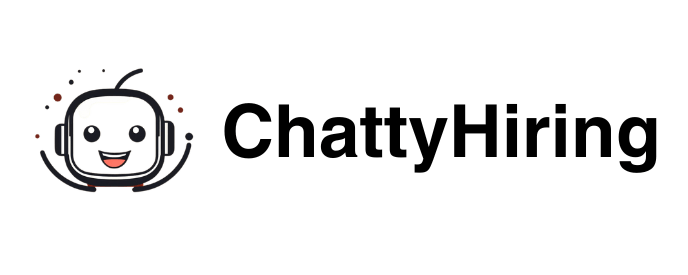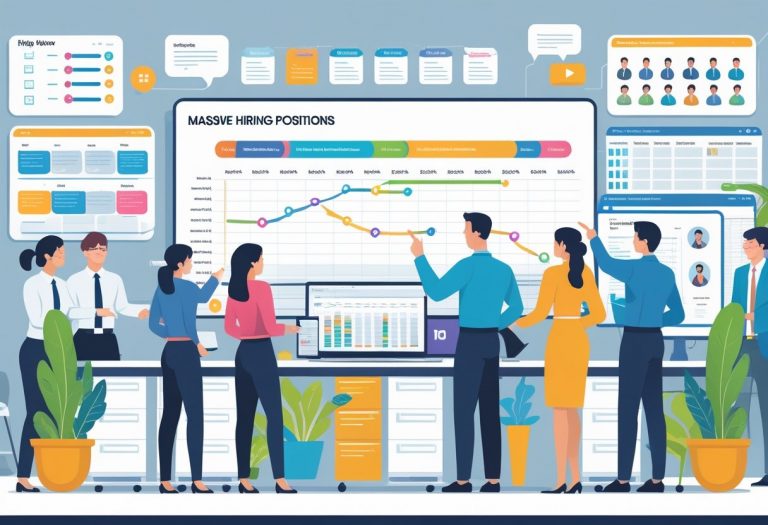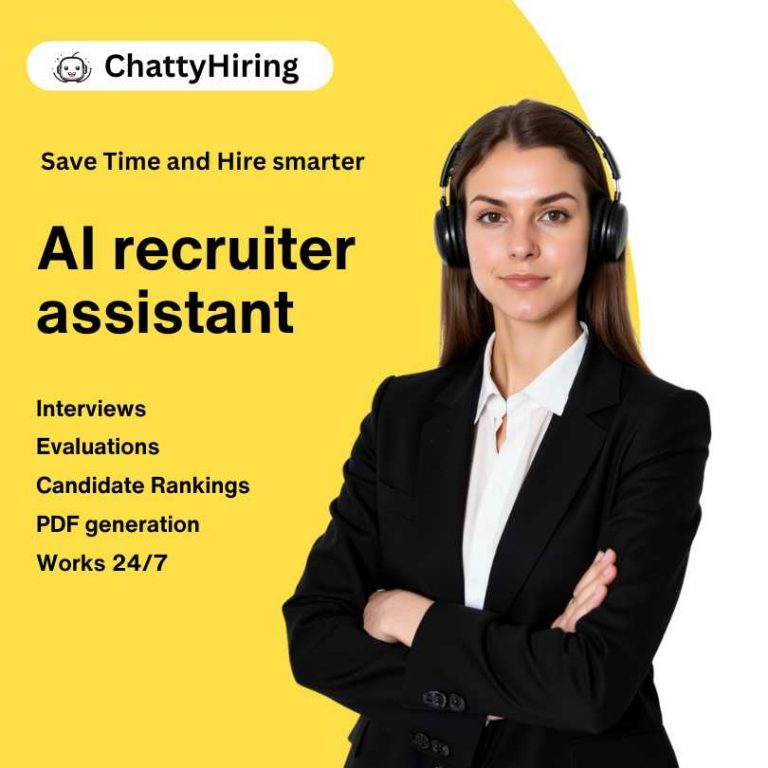When companies experience explosive growth or seasonal spikes, they often need to fill dozens or even hundreds of roles fast. This can overwhelm even seasoned talent acquisition teams, who may suddenly find themselves flooded with applications and racing to meet tight deadlines.

The key to handling massive hiring needs is automating repetitive tasks, streamlining candidate assessment, and keeping communication clear throughout the entire recruitment funnel. Companies that nail high-volume recruitment can turn what seems impossible into a smooth process that delivers excellent hires at scale.
Having the right systems and tools in place before applications start rolling in is crucial. Knowing how to balance speed with solid candidate evaluation, leveraging technology, and creating scalable onboarding processes makes high-volume hiring a true competitive edge.
Understanding Massive Hiring Positions

Companies face unique challenges when they need to fill dozens or hundreds of positions at once. High-volume recruitment calls for specific strategies that differ from traditional single-role hiring, especially when it comes to balancing speed and candidate quality.
What Is High-Volume Hiring?
High-volume hiring happens when organizations need to fill multiple roles quickly or manage a surge of applications. Mass hiring is all about recruiting lots of candidates fast, usually for roles that don’t require niche expertise.
Two main situations trigger this approach. First, companies may be expanding rapidly and need talent across multiple departments.
Second, a job posting might attract way more applicants than expected. A typical job ad might bring in 50 candidates, but high-volume scenarios can see over 250 applications per role.
After economic downturns, these numbers can climb even higher.
Key characteristics of mass recruitment:
- Filling multiple roles at once
- Shorter interview timelines
- Group assessments and interviews
- Standardized screening procedures
Common Scenarios Requiring Mass Recruitment
Rapid business growth is a major reason for bulk hiring. Companies like Amazon have announced plans to bring on tens of thousands of employees within months to support expansion.
Seasonal peaks also drive temporary mass hiring needs. Retail and hospitality often add staff during holidays or busy seasons, with quick onboarding for roles that don’t require much training.
Opening new facilities is another trigger. Manufacturing plants, distribution centers, and retail stores often need to staff up across all departments at once.
Common mass hiring triggers:
- Company expansions
- Seasonal business spikes
- New location launches
- Post-recession hiring surges
- Big project kickoffs
Balancing Speed and Quality in Bulk Hiring
Speed is critical in mass hiring, but it can easily lead to sacrificing candidate quality. The rush to fill roles often means assessments get skipped, resulting in underqualified hires.
Bad hiring decisions can mean high turnover and extra training costs. It’s important to keep evaluation standards high, even when moving quickly.
Research shows that 75% of resumes from high-volume job postings are unqualified, which creates screening bottlenecks. Organizations need a systematic way to spot top candidates fast.
Strategies for maintaining quality:
- Structured screening questions
- Automated resume filtering
- Standardized interview formats
- Skills-based assessments
- Reference checks for finalists
Tech solutions, like AI-powered screening tools, help reduce manual work and keep evaluations consistent.
Building an Efficient High-Volume Recruitment Process

A well-structured recruitment process with automated workflows and clear candidate evaluation stages cuts down time-to-hire without losing quality. Smart job ad optimization and multi-channel sourcing bring in more qualified applicants.
Developing a Scalable Hiring Plan
It all starts with forecasting talent needs across teams and timeframes. Analyzing past hiring data helps predict seasonal swings and growth demands.
The plan should break down role categories and skill requirements. This lets recruiters standardize their evaluation criteria for similar positions.
Batch hiring for similar roles makes things more efficient. Setting realistic timelines for each recruitment phase is key—while the average time-to-fill is 44 days, high-volume hiring needs to be a lot quicker.
Resource allocation is huge when juggling multiple openings. Assigning recruiters to specific role types (instead of individual jobs) boosts efficiency and candidate experience.
It’s smart to have a backup plan for sudden hiring spikes or urgent replacements. Keeping relationships with staffing agencies and freelance recruiters can help cover overflow.
Optimizing Job Descriptions and Postings
A sharp job description weeds out unqualified applicants before they even hit your pipeline. Clear requirements and expectations mean fewer, but better, applications.
Job ads should always include salary ranges and benefits. Being upfront attracts serious candidates and filters out those with different expectations.
Must-haves for job ads:
- Required skills vs. nice-to-haves
- Remote, hybrid, or on-site details
- Company culture and advancement paths
- Next steps in the hiring process
The job boards you choose matter. Niche platforms often deliver higher-quality candidates than general sites, so it’s worth testing and tracking results.
Social media recruiting is excellent for reaching passive talent. LinkedIn, industry forums, and professional groups can help you connect with experienced professionals.
Keep the application process simple and mobile-friendly. This ensures you don’t lose candidates who find your roles via social media or on their phones.
Streamlining Candidate Sourcing Strategies
Using multiple sourcing channels keeps you from relying too heavily on one method. Diversifying your approach helps surface the best platforms for each role type.
Employee referral programs are gold for finding excellent candidates with higher retention. Offering meaningful incentives gets your team involved in talent acquisition.
Effective sourcing strategies:
- University partnerships for entry-level talent
- Industry-specific job boards for specialized roles
- Networking events and conferences
- Alumni and professional association outreach
Passive candidates often have the skills you need. Building and maintaining talent pipelines through regular outreach is key.
Reengaging past applicants gives you a head start with pre-screened talent who may now be an even better fit. This saves both time and money.
Track your sourcing data to see which channels deliver top hires. Look at application-to-hire ratios and employee performance by source.
Leveraging Recruitment Software and Technology
Applicant Tracking Systems (ATS) are the backbone of high-volume recruitment. Platforms like Workable, BambooHR, and Lever automate resume screening and keep candidate communications organized.
Key ATS features for bulk hiring:
- Automated resume parsing and keyword matching
- Bulk email templates and scheduling
- Interview coordination tools
- Reporting dashboards and analytics
Skills testing platforms help weed out unqualified candidates early. This saves tons of time and lets you focus on top performers.
AI-powered screening tools can process applications at scale, but make sure you’re not missing out on great candidates due to overly strict keyword filters.
Automated communications keep candidates in the loop without overloading recruiters. Status updates and feedback emails improve candidate experience and reduce manual work.
Make sure your recruitment tech integrates with your existing HR systems. This avoids double data entry and gives you a seamless candidate journey from application to onboarding.
Enhancing Candidate Evaluation and Experience at Scale
To pull off successful mass hiring, you need systematic screening, efficient interview formats, and consistent communication. These tactics help you maintain quality while moving hundreds or thousands of candidates through the funnel.
Screening and Pre-Employment Assessments
Pre-screening helps eliminate unqualified candidates before recruiters get involved. Skills tests should be the first step in your process, not just resume reviews.
Resume parsing tech pulls out key info automatically, letting recruiters sort by experience, location, and qualifications without manual effort.
Skills assessments work best when they:
- Directly test job-relevant abilities
- Take 15-30 minutes to finish
- Cover both technical and soft skills
- Score and rank results automatically
Focus pre-employment assessments on core competencies. For customer service, test communication and problem-solving. For tech roles, use coding challenges or industry-specific tests.
Automated screening can shrink candidate pools by 80-90% while keeping quality high. That way, recruiters only review the most qualified applicants.
Efficient Interview Structures for Mass Hiring
Volume recruiters see a lot of candidate drop-off during traditional interviews. Streamlined formats help keep candidates engaged and evaluations thorough.
One-way video interviews let candidates answer preset questions on their own time. This saves time for both sides and makes it easy to compare applicants.
Interview formats for high-volume hiring:
| Interview Type | Best For | Time Required |
|---|---|---|
| One-way video | Initial screening | 10-15 minutes |
| Group interviews | Cultural fit | 45-60 minutes |
| Skills panels | Technical assessment | 30-45 minutes |
Group interviews are excellent for roles needing teamwork or customer service skills. Multiple candidates join the same session, so you can compare communication and collaboration styles.
Batching interviews into tight time blocks is more efficient than spreading them out. For entry-level roles, one round may be enough, while management hires might need several stages.
Maintaining Effective Candidate Communication and Branding
Poor candidate communication hurts your employer brand and lowers offer acceptance. Most candidates who have a bad experience will tell others about it.
Automated messaging keeps candidates updated at key milestones, like application receipt, assessment results, and interview scheduling.
Key communication touchpoints:
- Application confirmation within 24 hours
- Assessment results and next steps
- Interview invites and prep info
- Final decisions with timelines
Candidate experience still matters in high-volume hiring. Communicate quickly, stay transparent, and set clear expectations throughout the process.
Personalized emails work better for top candidates. Use their name, mention the specific role, and include relevant feedback to show you care about their application.
Consistent employer branding in all communications builds trust. Make sure your templates, interview invites, and rejection notes reflect your company’s culture and values.
Let candidates know when they’ll hear back and stick to those deadlines. This keeps them engaged and interested in your roles.
Onboarding, Metrics, and Continuous Improvement
Large-scale hiring needs a structured onboarding system that can handle lots of new hires at once. Tracking the right metrics helps you optimize your process and maintain quality.
Establishing a Scalable Onboarding Process
A scalable onboarding process gets lots of new hires up to speed without losing effectiveness. Standardizing your approach is key when bringing on dozens or hundreds of employees at once.
Digital onboarding platforms are essential. Online training modules let new hires complete paperwork and basic learning before day one, easing the load on managers and HR.
Template-based workflows bring consistency across teams. Each role has a checklist for must-do tasks like paperwork, system access, and training. Managers can tweak templates for their specific needs.
Batch onboarding groups new hires with similar start dates. Group orientations and training sessions make resource use more efficient during busy hiring periods.
Set clear timelines for each onboarding step. Time-to-productivity (how quickly new hires start contributing) is a solid metric—most companies aim for 30-60 days.
Mentor assignments pair new hires with experienced team members. This support system helps new employees settle in faster and spreads the onboarding workload beyond just HR and managers.
Tracking and Analyzing Hiring Performance Metrics
Effective metrics give clear insights into hiring performance and point out areas that need improvement.
Talent acquisition teams should track specific data points to make smarter decisions about their workflows.
Time-to-hire tracks the days between posting a job and getting an offer accepted.
For high-volume recruitment, this metric highlights bottlenecks in the hiring funnel.
Most organizations aim for a time-to-hire of 20-30 days for standard roles.
Quality of hire looks at how well new hires perform after onboarding.
This includes metrics like performance reviews, 90-day retention rates, and feedback from hiring managers.
If quality of hire scores are low, it might mean your screening or selection process needs work.
Completion rates of onboarding tasks show how effective your onboarding process is.
Low completion rates can signal that the onboarding workflow is too complicated or unclear.
Candidate experience scores capture how applicants feel about your recruitment process.
Negative experiences can hurt your employer brand and lower offer acceptance rates.
Regular feedback surveys help pinpoint issues in the candidate journey.
Tracking different retention rates for graduating classes helps uncover trends.
This makes it easier to see which hiring cycles or sourcing methods bring in excellent long-term employees.
Cost Management and Resource Optimization
Cost per hire becomes critical when filling hundreds of positions simultaneously. Companies must balance speed and quality while controlling expenses throughout the hiring process.
Technology investments reduce long-term costs by automating repetitive tasks. Applicant tracking systems streamline initial candidate screening and interview scheduling.
Online training platforms deliver consistent onboarding content without the need for live instructors.
Internal referral programs usually cost less than partnering with external search firms. Employee referrals often lead to higher retention rates and faster assimilation into company culture.
Bulk purchasing of background checks, pre-employment assessments, and other talent acquisition services decreases per-unit costs. Many vendors provide volume discounts for organizations processing large candidate pools.
Resource allocation planning is essential for adequate staffing during peak recruitment drives. Companies may require temporary talent acquisition specialists or additional hiring managers.
Planning ahead prevents bottlenecks that can delay the entire hiring workflow.
Cost per hire calculations should include all expenses from job postings to onboarding completion. This covers recruiter hours, advertising fees, interview costs, and onboarding resources.
Organizations can optimize costs by standardizing interview formats and using structured assessment tools. This minimizes time spent per applicant while maintaining excellent quality of hire.
-

A passionate advocate for the future of HR innovation. With expertise in leveraging AI to revolutionize recruitment processes, Carlos has a clear vision: empower HR teams while creating meaningful candidate experiences.
View all posts





